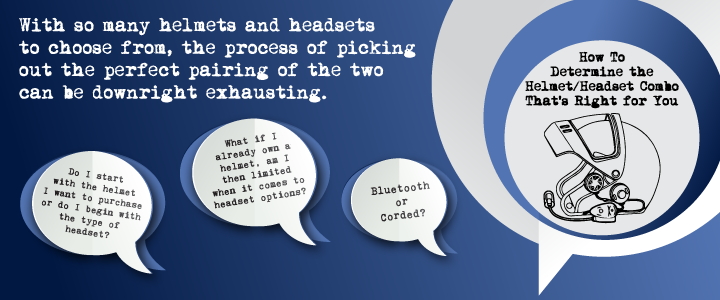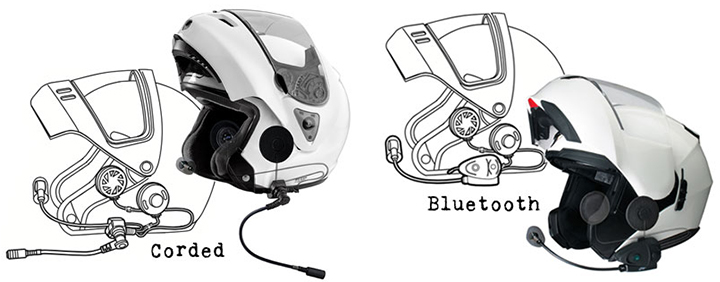
With so many helmets and headsets to choose from, the process of picking out the perfect pairing of the two can be downright exhausting. Do I start with the helmet I want to purchase or do I begin with the type of headset? What if I already own a helmet, am I then limited when it comes to headset options? Bluetooth or corded? Boom mic or button? Will there be additional parts I'll need to buy for the headset to work flawlessly with my bike and helmet? See what I mean. Daunting. But don't worry, we've got you covered!
In this article, we'll address all these question and more as we share what we believe to be a clear, easy, and painless way to discover and purchase the right setup for you, using a fictional rider as an example through each step of the process.
Side Note: For the purpose of this blog post we're assuming the rider owns a Goldwing with a built-in audio system. If you have another bike, you're options and choices will be a bit different. But don't worry. If this is the case, please do not hesitate to give us a call and we'll get you dialed in with the perfect setup that best fits your needs.

When a customer calls inquiring about their headset options, the first thing we ask them is what kind or type of helmet the headset will end up in. The answer will refine and focus the options right from the start. For example, maybe the rider doesn't plan on wearing a helmet at all. If that's the case, their choices will be limited to helmet-less headsets such as IMC's HSG140P. If you have a full face helmet your options will be a full face or universal unit. Planning to purchase a modular helmet? Then you'll want to get the universal or modular style headset.
Obviously, there are a lot of different types of headsets out there and some will fit specific types of helmets (Full Face, Open Face, Modular) or specific helmet models (Nolan, Vega, Arai, Shark models), while others are considered universal and can fit in most any type of open face, full face, or modular helmet. But keep in mind that, in order to fit universally, these types of headsets might compromise on key features - like speaker size - that are important to you. More on that in Step Three below.
Side Note: It can be challenging to select a helmet/headset combo without trying on the helmet first. We get that. That's why we offer, should you prefer, to send you the purchased helmet first to try on and make sure it fits right. If it does, send it back and we'll install the headset then ship the combo back to you. If the helmet doesn't fit to your liking, send it back and we'll give you a refund. You don't even have to pay for return shipping. How convenient is that?
So what about you? What type of helmet do you have or intend to have?
No helmet
Shorty/Half-Helmet: Vega XTA, HJC CS-2N, Cyber U-72
Open Face: GMax GM32, HJC IS-33, LS2 OF569
Full Face: HJC IS-Max 2, Stealth Insight, Scorpion EXO Series
Modular: GMax GM64, Fly Street Tourist, Schuberth C3 Pro
Model Specific: Nolan N44/N40/N104, Arai, Vega Summit, Shark
Rider's Verdict: Full Face
There's a lot that can be said about the difference between these two types and a myriad of reasons why a rider would swear by one over the other. Suffice it to say that the choice really comes down to rider preference more than anything else. The vast majority of WingStuff's customers choose corded so that's what we'll stick with. For more on this, check out our Corded v. Bluetooth Headset blogpost.
Rider Verdict: Corded

The next questions you want to ask yourself are, "What will I need my headset to do for me?" and, "How much am I willing to spend?" In other words, what's most important to you? Will the headset mainly be used for talking to your co-rider, using a CB to communicate with other riders, listening to your favorite tunes, or all of the above? Some sets excel at providing clear rider/passenger communication while others focus on creating great sound for music with larger speakers.
Along with your performance needs you will want to balance it out with your pocketbook. You may want the best, most expensive unit but don't want to spend a lot of coin to get it. Are you looking to save money with a low-cost option or is the quality your main priority? As with many things in life, not all headsets are created equal. By and large, the more it costs, the better it's going to perform. If you're looking for a simple set to talk back and forth with your passenger, you will probably want an economically savvy headset like an IMC or J&M HS CD9279 UN HO Universal Performance Headset w/HO AeroMike. Perhaps you want an intermediate unit that does a pretty good job at all of the above but doesn't break the bank. In that case, we'd recommend something like the J&M 279 Deluxe Performance Series Headsets. If, on the other hand, you're looking for a high end set with clearer, fuller sound then you'll want to take a look at the J&M 787 Elite Series Headsets.
Side Note: J&M corded headsets require an additional "lower cord" to connect the unit to your Goldwing. The Elite Series headsets require an 8-pin "Z-style" lower cord and the Performance Series headsets require the 8-pin "P-Style" lower cord. What does this mean for you? Say you have a Performance Series set in your helmet, but you want to upgrade to the new Elite Series. In that case, you won't be able to use your current lower cord (P-Style) and will need to purchase the Z-Style cord which is compatible with the Elite Series. If you want to get a new headset and stay in the same series (Performance to Performance or Elite to Elite) and your lower cord is still in working condition then you're good to go.
Tip: Need a lower cord? Make sure to include its cost when researching and budgeting the overall pricing of your new helmet/headset.
The answer to the above questions will help you determine what kind of headset you require. We know that, typically, most riders want a headset for all of the above so, for the purpose of this illustration and based on our riding experience, we're going to assume you fall into that category as well. This means you'd want a Universal unit. Just keep in mind that choosing a headset that does a good job at everything overall means the individual aspects - music, CB, etc. - probably aren't as good. Think of it as Jack of All Trades, Master of None.
So what about you? What type of headset are you looking for?
Economically Savvy Open-Faced Helmets
Intermediate AND FOR Modular Helmets
High End Full Faced Helmets
Universal
Rider Verdict: Universal High-End Headset
Now that you've figured out the right headset for the type of helmet you have (or intend to have), it's time to determine the most appropriate method for installation. Your options are to do it yourself, following the manufacturer's instructions, or have it professionally installed. The simplest way to determine this is to ask, "Am I comfortable installing this myself?" If not, let a professional handle it. Keep in mind, the overall experience with your headset/helmet combo is highly dependent on the placement of the unit and you want to be sure it's done right the first time. Of course, there are many riders out there who will install their own headsets per the manufacturer's instructions, know what they're doing, and love the end result. That said, if you aren't sure please do not hesitate to give us a call. We have certified professional installation technicians here on-site that will be more than happy to take care of it for you. Plus it doesn't hurt that WingStuff.com offers an Install Guarantee for the life of the helmet*. No headache. No worries. Just good ol' fashioned customer service. Sounds good, right?
Side Note: Some helmets are more acoustically favorable than others. What this means is that you might install the same headset into two different helmets and get two totally different sounds because of the design of the helmets. Personal preference and the shape of the rider's head will also affect perceived sound quality.
So what about you? Would you install it yourself or have it professionally installed?
Rider Verdict: Professionally Installed by WingStuff
In our experience, we've found that the educated consumer is much more likely to achieve the desired result when it comes to purchasing a helmet/headset combination. Do the research, talk to your friends, read product reviews on WingStuff.com and consult a professional like WingStuff with any questions you might have. We're more than happy to help!
Tip: Before purchasing your helmet and/or headset, make sure to first do some research (Just like you are right now!) A great resource are Goldwing forums such as GLRiders.com. Typically, signing up is easy and you can get tons of great information from fellow riders or ask your own questions and receive helpful answers.
*Helmet and Headset replacement are not a part of Install Guarantee. Please refer to manufacturer's warranty information for further details.
Kevin
09.28.2015
Cruise Control
10.01.2015